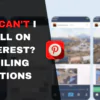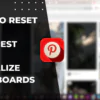Pinterest isn’t just a platform for sharing visual inspiration—it’s also a powerful tool for trend forecasting. By tapping into Pinterest’s massive database of images, keywords, and user interactions, brands and marketers can anticipate emerging trends, optimize product development, and tailor content strategies to meet consumer demand. In this guide, we explore how to use Pinterest for trend forecasting, covering everything from data analysis to practical applications for your business.
Understanding the Power of Pinterest Data
Pinterest hosts hundreds of millions of users, each contributing to a vast ecosystem of visual content. This extensive repository of Pins, boards, and search queries makes Pinterest a rich source for trend analysis. Here’s why Pinterest data is invaluable for forecasting trends:
- Massive User Base: With over 400 million active users, Pinterest reflects diverse consumer interests.
- Seasonal Insights: Pinterest trends fluctuate with seasons, holidays, and cultural events.
- Keyword Data: Users’ search queries offer insight into current interests and emerging topics.
- Visual Trends: The types of images that gain traction can signal shifts in consumer aesthetics and preferences.
By analyzing these data points, brands can identify not only what is trending now but also predict what will be popular in the near future.
Getting Started: Tools and Resources
To harness Pinterest for trend forecasting, you’ll need the right tools and resources. Here are some essential ones:
Pinterest Trends and Pinterest Predicts
Pinterest provides built-in tools such as Pinterest Trends and Pinterest Predicts. These tools allow users to:
- Monitor Popular Keywords: Identify what users are searching for and how trends change over time.
- Seasonal Forecasting: Understand which topics gain momentum during specific seasons.
- Data-Driven Insights: Get a snapshot of emerging trends based on Pinterest’s proprietary data.
Third-Party Analytics Tools
Several third-party tools integrate with Pinterest to offer more granular insights:
- Tailwind: Besides scheduling, Tailwind provides detailed analytics that help pinpoint which types of content perform best.
- Sprout Social and Hootsuite: These platforms aggregate Pinterest data along with other social channels, offering a comprehensive view of digital trends.
- Google Trends: While not specific to Pinterest, Google Trends can complement your Pinterest data by showing broader search interest.
Manual Analysis
Even with advanced tools, manual analysis remains critical. Regularly browsing popular boards, monitoring competitor activity, and noting the type of visual content that garners high engagement can provide qualitative insights that data alone might miss.
How to Analyze Pinterest Data for Trend Forecasting
Now that you’re equipped with the right tools, here’s how to analyze Pinterest data effectively:
1. Keyword Trend Analysis
Keywords are at the heart of Pinterest search. To forecast trends:
- Identify Rising Keywords: Use Pinterest Trends to spot keywords that are gaining popularity. Look for steady increases in search volume over weeks or months.
- Seasonal Patterns: Observe how certain keywords peak during specific times of the year. For instance, “summer fashion” or “holiday recipes” will see seasonal spikes.
- Long-Tail Keywords: Pay attention to long-tail keywords that indicate niche interests. These can signal emerging sub-trends.
2. Engagement Metrics
Engagement metrics such as saves, clicks, and comments can offer insights into what resonates with users:
- High-Performing Pins: Analyze which Pins in your niche receive the most engagement. What are their common features—color schemes, design styles, or topics?
- Repins and Shares: Content that is frequently repinned or shared is likely tapping into an emerging trend. Look at the boards where these Pins are saved for broader context.
- Comments and Feedback: Read user comments for qualitative insights. Sometimes, users mention what they like or want to see more of.
3. Visual Content Analysis
Since Pinterest is a visual platform, the aesthetics of Pins matter significantly:
- Design Elements: Note recurring visual elements like color palettes, layouts, and image styles that perform well.
- Content Themes: Identify popular themes, such as minimalism, vintage aesthetics, or bold, vibrant imagery.
- Content Format: Compare the performance of different formats—static images, videos, infographics, and Idea Pins—to understand what your audience prefers.
4. Board and Category Insights
Boards group Pins by topics and can reveal broader trends:
- Popular Boards: Explore boards with high follower counts in your niche. What topics are consistently highlighted?
- Category Performance: Look at Pinterest’s category-based insights. Categories like fashion, home décor, or fitness might reveal different trend cycles.
- Competitor Boards: Analyzing boards from competitors can provide clues about what trends are capturing market attention.
Practical Applications of Pinterest Trend Forecasting
Once you have gathered and analyzed your data, it’s time to apply these insights to your business strategy.
Content Creation and Marketing
- Align Your Content: Create Pins that align with trending keywords and themes. If you notice a surge in searches for “sustainable fashion,” develop content around eco-friendly products.
- Optimize Timing: Schedule your Pins to coincide with seasonal peaks or specific trend cycles. For example, launch relevant content ahead of seasonal events.
- Test and Iterate: Use A/B testing on your Pins to determine which visuals and headlines drive the most engagement. Adapt your strategy based on performance data.
Product Development
- Identify Gaps: Use trend analysis to identify unmet needs in your market. If emerging trends indicate a shift toward a particular style or feature, consider how your products can evolve to meet this demand.
- Speed to Market: Early insights allow you to innovate quickly. The faster you align product development with consumer trends, the greater your competitive advantage.
- Feedback Loop: Monitor engagement metrics on Pinterest as a feedback loop to refine products post-launch.
Advertising and Campaign Planning
- Targeted Ads: Leverage Pinterest Ads to target users interested in trending topics. Use keyword insights to refine your ad targeting and improve ROI.
- Creative Optimization: Adapt your ad creatives to reflect current trends. For instance, if minimalist designs are trending, ensure your ads align with that aesthetic.
- Budget Allocation: Allocate more budget to campaigns that align with high-engagement trends identified through your analysis.
Brand Positioning
- Establish Thought Leadership: Use trend forecasting to position your brand as a leader in innovation. Regularly publish insights and predictions based on your Pinterest data.
- Content Partnerships: Collaborate with influencers and content creators who are known for their trend insights. This can amplify your reach and credibility.
- Storytelling: Leverage trends to tell a compelling brand story. Share how your products or services are evolving with emerging trends to keep your audience engaged.
Future Trends in Pinterest Forecasting
As Pinterest evolves, so too will its role in trend forecasting. Here are some emerging trends to watch:
- Enhanced AI Integration: Expect more advanced AI tools that provide predictive analytics, helping marketers anticipate trends before they become mainstream.
- Real-Time Data Visualization: Improved dashboards and real-time data feeds will allow for quicker decision-making and trend identification.
- Cross-Platform Analytics: Integration with other social media platforms will offer a holistic view of consumer behavior, bridging data from Pinterest, Instagram, and beyond.
- User-Generated Insights: Leveraging comments, reviews, and user feedback will become increasingly important in understanding nuanced consumer trends.
Challenges and Considerations
While Pinterest offers significant potential for trend forecasting, there are challenges to be aware of:
- Data Overload: With vast amounts of data available, it can be overwhelming to filter out the noise and focus on actionable insights.
- Changing Algorithms: Pinterest’s algorithms are continuously evolving, which can affect data consistency and trend analysis.
- Privacy Concerns: As with any data collection, ensuring user privacy and complying with data protection regulations is crucial.
- Resource Intensive: Effective trend forecasting may require investment in advanced tools and dedicated personnel.
Conclusion
Pinterest is much more than a platform for visual inspiration—it’s a dynamic tool for trend forecasting. By leveraging its rich data, brands can gain valuable insights into consumer behavior, predict emerging trends, and adapt their strategies accordingly. Whether you’re focusing on content creation, product development, or advertising, integrating Pinterest trend analysis into your marketing strategy can provide a significant competitive edge.
As we move further into 2025, staying ahead of the curve will depend on your ability to harness these insights and turn data into actionable strategies. Embrace the power of Pinterest for trend forecasting, and let your brand thrive in an ever-changing digital landscape.






